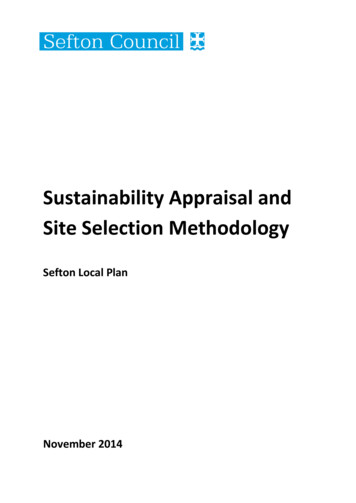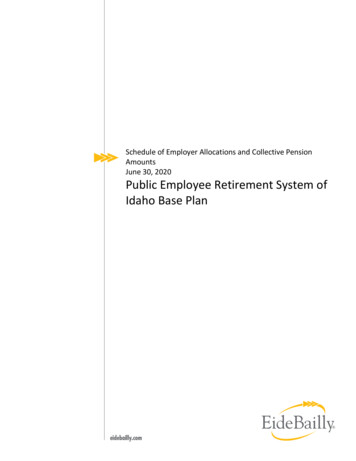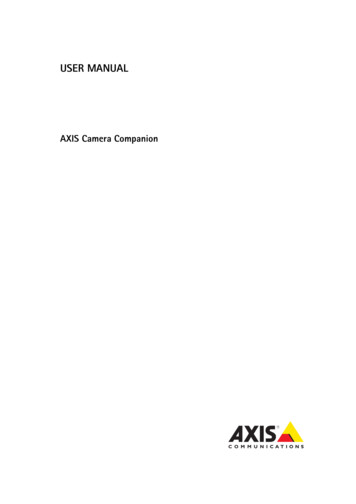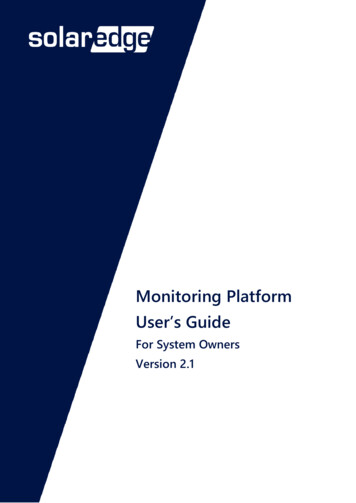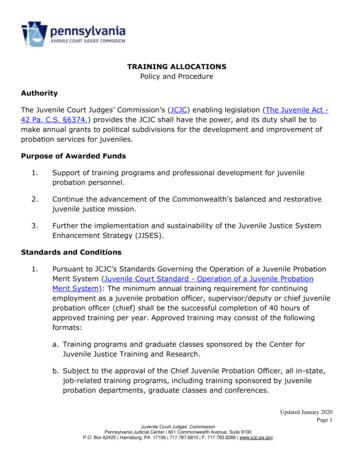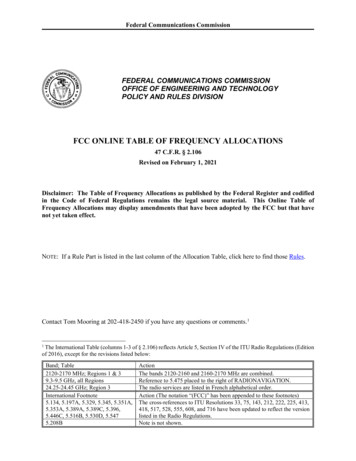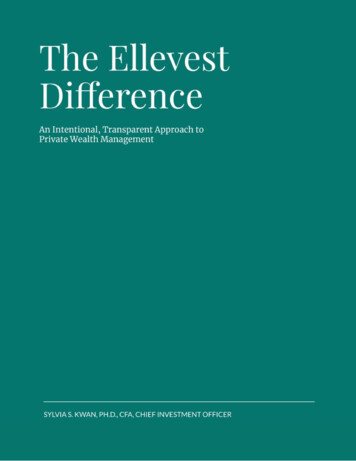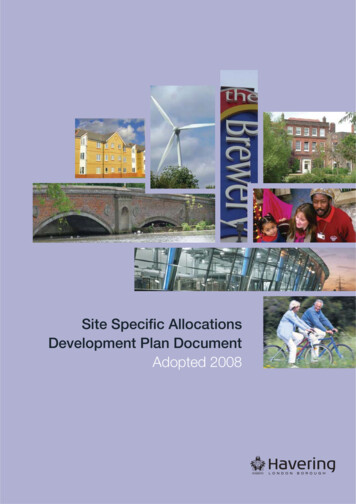
Transcription
Site Specific AllocationsDevelopment Plan DocumentAdopted 2008
2As well as satisfying the Site Specific Allocation Policy, applications for planningpermission will also be judged against the relevant Core and Development ControlPolicies of the Core Strategy and related Supplementary Planning Documents.
3Contents12345IntroductionHow to use this documentThe sitesRelationship to the Core StrategySite Specific Allocation policies5671323Places to liveSSA1Harold Wood HospitalSSA2Whitworth and Broxhill Centres2528Town centresSSA3Elm Park parades32CultureSSA4SSA5SSA6SSA735373942Arnold’s Field Community WoodlandWarwick Lane Community WoodlandRainham Quarry Community WoodlandRomford Ice RinkCommunity NeedsSSA8Upminster Cemetery and South Essex Crematorium 45TransportSSA9SSA10Channel Tunnel Rail LinkCrossrail4849London Riverside sites50Places to liveSSA11Beam ParkSSA12Rainham WestSSA13Rainham - Land Between Railway and Broadway525763TransportSSA14SSA156669Rainham Traffic Management SystemRainham Station Transport Interchange and CivicSquareTown CentresSSA16Rainham CentralAs well as satisfying the Site Specific Allocation Policy, applications for planningpermission will also be judged against the relevant Core and Development ControlPolicies of the Core Strategy and related Supplementary Planning Documents.73
4CultureSSA17SSA18London Riverside Conservation ParkIngrebourne Creek7781HeritageSSA19Rainham Hall and Grounds84As well as satisfying the Site Specific Allocation Policy, applications for planningpermission will also be judged against the relevant Core and Development ControlPolicies of the Core Strategy and related Supplementary Planning Documents.
51 Introduction1.1Havering’s Local Development Framework (LDF) is a portfolio ofdifferent documents which are concerned with the future planning ofthe borough. The Core Strategy document is the first document theCouncil has prepared in its LDF and it sets the Council’s approach tothe planning of the whole borough up to 2020 and sets the frameworkfor this document, the Romford Area Action Plan and Joint Waste Planand the other Local Development Documents (LDDs). This iscomplementary to the Site Specific Allocations Development PlanDocument. This sets out the specific allocations for individual sitesacross the borough except for sites in Romford Town Centre which willbe identified in the Romford Area Action Plan, sites for wastemanagement which will be identified in the Joint Waste DevelopmentPlan Document and specific sites/preferred areas for mineralsextraction which will be identified in a separate Minerals DevelopmentPlan Document. The sites identified in this document are considerednecessary to deliver the vision, objectives and policies of the CoreStrategy.As well as satisfying the Site Specific Allocation Policy, applications for planningpermission will also be judged against the relevant Core and Development ControlPolicies of the Core Strategy and related Supplementary Planning Documents.
62 How to use thisdocument2.1This documents starts by, in Section 3, providing the background tothe selection of sites included in this document. It clarifies which sitesthis Development Plan Document is concerned with, how they havebeen identified and the relationship with national and regional planningpolicy guidance. Section 3 concludes with an explanation of how theimplementation of the sites will be monitored. The sites included in thisdocument are necessary to deliver the Vision, objectives and policies ofthe Core Strategy. Section 4 therefore sets out the relationshipbetween the sites and the Core Strategy, looking first at the Vision andobjectives for the future planning of the borough and then identifyingwhich Core Policies each site will help deliver. Section 5 then presentsthe Site Specific Allocation policies which where necessary includespecific guidance over and above that provided in Core Strategy, Coreand Development Control policies. Each Site Specific Allocation policyis supported by a reasoned justification which provides the rationale foreach allocation.As well as satisfying the Site Specific Allocation Policy, applications for planningpermission will also be judged against the relevant Core and Development ControlPolicies of the Core Strategy and related Supplementary Planning Documents.
73 The SitesWhich sites are included?3.1Despite over 50% of the borough being within the Green Belt and theurban area being well developed there are a number of significantdevelopment opportunities in Havering which can help deliver theVision, objectives and policy of the Core Strategy.Most of the major sites fall into two key strategic areas.1. London Riverside which is designated as an Opportunity Areawithin the London Plan due to the development opportunities itpresents at the heart of the Thames Gateway for new jobs,sustainable communities and leisure and recreation.2. Romford Town Centre which is the Thames Gateway’s and EastLondon’s premier town centre for retailing and entertainment, butwhich also has potential for a significant increase in housingcapacitySites within Romford Town Centre will be identified within the separateRomford Area Action Plan.3.2This document excludes waste management sites which will becovered in the Joint Waste DPD and specific sites/preferred areas forminerals extraction which will be identified in a separate Minerals DPD.What is the source of the sites?3.3The sites identified in this document come from a number of sourcesincluding:xxxxx3.4Sites submitted by landowners in response to a Council requestfor details of sites sent in December 2004Sites identified through the London Housing Capacity StudySites identified through the multi agency regeneration of LondonRiversideSites identified in the Government publication “Greening theGateway” as part of the Government’s Sustainable CommunityPlan.Sites put forward by the London Borough of Havering.None of the sites within the 1993 Havering Unitary Development Planhave been carried forward.As well as satisfying the Site Specific Allocation Policy, applications for planningpermission will also be judged against the relevant Core and Development ControlPolicies of the Core Strategy and related Supplementary Planning Documents.
8Relationship of this document to national and regional planningguidance3.5In line with Planning Policy Statement 1 ‘Delivering SustainableCommunities’, 2005, and the London Plan, 2004, the focus has beenon identifying sites and proposals which can contribute to the deliveryof sustainable communities. However, regard has also been had to theneed to satisfy other national and regional government guidance whereit makes specific reference to land allocations. What follows is asummary of the relevant national and regional government guidancewith regard to the identification of site specific allocations.Places to live3.6Planning Policy Statement 3, ‘Housing’, 2006, states that sufficientdeliverable sites should be shown on the plan's proposals map toaccommodate at least the first five years of housing developmentproposed in the plan. 1 Early alterations to the London Plan set ahousing target for Havering of 535 new homes per year from 2007/08to 2016/17 . Core Policy CP1 ‘Housing Supply’ identifies the sources ofnew supply which will deliver these targets as appropriate through thelife of the plan. The Site Specific Allocations will make a significantcontribution to meeting this target. However it is important to note thatthe Whitworth and Broxhill Centre scheme was not included incalculating the borough’s housing capacity from which the revisedhousing target was derived. This is because it is a site removed fromthe Green Belt. Therefore it is not necessary to deliver the 535 newhomes per year target but in line with the London Plan, will helpmaximise supply and meet local and sub-regional housing need. TheHousing Trajectory provided at Annex 3 of the Core Strategy shows theanticipated sources of new housing supply up to 2020.Town CentresRetail3.7Planning Policy Statement 6 states that in planning for growth in theirtown centres, local planning authorities should allocate sufficient sitesto meet the identified need for at least for first five years from theadoption of their development plan documents.2 This applies to towncentre uses especially retail, leisure and office uses.3.8Havering’s Retail and Leisure Study 2006, identifies future comparisonand convenience floorspace requirements up to 2018 for Romford andeach of the district centres. The study concludes that the districtcentres will experience limited growth during the plan period andtherefore no change to their boundaries is necessary. It found that thecentre boundaries had been successful in helping to achieve compact12Planning Policy Statement 3, Housing, Paragraph 54, CLG, 2006Planning Policy Statement 6, Town Centres, paragraph 2.52, DCLG, 2005As well as satisfying the Site Specific Allocation Policy, applications for planningpermission will also be judged against the relevant Core and Development ControlPolicies of the Core Strategy and related Supplementary Planning Documents.
9and focused town centres. The Council does not consider that it isnecessary to identify specific sites within the district centres to meet themodest additional convenience and comparison floorspacerequirements identified up to 2018 as the Council is confident thatsufficient sites are available and will be brought forward by the privatesector, unless there is a clear cut reason for doing so, as is the case inElm Park and Rainham.3.9The most significant shortfall identified by the study was for comparisonfloorspace in Romford Town Centre. This will be addressed through theRomford Area Action Plan.Culture3.10Cultural provision encompasses a wide range of activities from sportand leisure, convenient access to a network of open space, arts andcreative activities and industries, and libraries, heritage centres ormuseums.3.11Planning Policy Statement 6 states that local planning authoritiesshould allocate sufficient sites to meet the identified need for at leastfive years from the adoption of their development plan documents fortown centre uses including leisure uses. The Havering Retail andLeisure Study, 2006, recognised that identifying future need for nonretail town centre uses is very difficult, but does identify a significantgrowth in leisure expenditure in the borough which will need to besatisfied.3.12As the borough’s primary centre for leisure the Romford Area ActionPlan will consider options for meeting this growth in expenditure.3.13PPG17 states that assessments and audits will allow local authoritiesto identify specific needs and quantitative or qualitative deficits orsurpluses of open space, sports and recreational facilities in theirareas. 3 The Havering Open Space and Sports Assessment 2005,shows that Havering has a relatively good quantity of public parks butthat there are local pockets of deficiency across the borough, inparticular there are significant areas which are deficient in access todedicated children’s play areas. In terms of sports facilities theassessment identifies that up to 2016 there will be a need for a furthertwenty junior football pitches, two additional artificial turf pitches andthree, four court additional sports halls. The Council will also seek toaddress deficiencies identified in the assessment through whereappropriate developer contributions, the balance of open spaceprovision and dual use of educational sports facilities and thereforedoes not consider it necessary to identify specific sites.3Planning Policy Guidance Note 17, Planning for Open Space Sport and Recreation, Paragraph 4,DCLG, 2002As well as satisfying the Site Specific Allocation Policy, applications for planningpermission will also be judged against the relevant Core and Development ControlPolicies of the Core Strategy and related Supplementary Planning Documents.
103.14However in line with the Havering Open Space and Sports Assessmenta site has been identified within the north west of the Borough wherecurrent access to swimming pools is poorest.3.15In addition a number of sites have been identified to help realise thevision of the Core Strategy to increase the opportunities for recreationwithin Havering’s countryside and to implement the ODPM’s Greeningthe Gateway Strategy.4Employment3.16Planning Policy Guidance Note 4 states that in allocating land forindustry and commerce planning authorities should be realistic in theirassessment of the needs of business.5 They should aim to ensure thatthere is sufficient land available which is readily capable fordevelopment and well served by infrastructure, and ensure there is avariety of sites available to meet differing needs. In line with thefindings of Havering’s Employment Land Study, the Core Strategy hasrationalised the extent of Strategic Industrial Areas and SecondaryEmployment Areas in the borough. In accordance with Core StrategyCore Policy CP1 the first priority for de-designated areas will behousing. Due to their scale the de-designated parts of the RainhamEmployment Area have been identified as site allocations to ensurethat sustainable communities are realised in this key part of theThames Gateway.3.17The future strategy for employment areas within Romford Town Centrewill be resolved within the Romford Area Action Plan.Minerals3.18Minerals Planning Statement 1 states that the minimum length of the(minerals) landbank should reflect the time needed to obtain planningpermission and bring a site into full production.6 This should be takenas 7 years. A landbank less than 7 years is an indication that additionalresources may need to be permitted. Early Alterations to the LondonPlan published in December 2006 set an East London apportionmentof 0.5 million tones, and require a minimum seven years’ output to bemaintained in London (7 million tones). The Council will bring forwarda separate Development Plan Document to identify ‘preferred areas’and sites for minerals extraction.Waste3.19456Planning Policy Statement 10 states that Waste Planning Authoritiesshould be able to demonstrate how capacity equivalent to at least tenyears of the annual rates set out in the Regional Spatial Strategy couldCreating Sustainable Communities, Greening the Gateway, Implementation Plan, DCLG, 2005Planning Policy Guidance Note 4, Industrial, Commercial Development and Small Firms, DCLG, 1992.Minerals Planning Statement 1, Planning and Minerals, CLG, 2006As well as satisfying the Site Specific Allocation Policy, applications for planningpermission will also be judged against the relevant Core and Development ControlPolicies of the Core Strategy and related Supplementary Planning Documents.
11be provided, and identify the types of waste management facilities thatwould be appropriately located on the allocated site or in the allocatedarea, taking care to avoid stifling innovation in line with the wastehierarchy.7 Revised draft minor alterations to the London Planpublished in December 2006 set out these annual rates.83.20Havering has agreed to produce a Joint Waste Development PlanDocument with other East London Waste Authority (ELWA) boroughs.The East London Waste Authority is a statutory waste authorityresponsible for waste disposal in its area, which covers the fourLondon boroughs of Barking & Dagenham, Havering, Newham andRedbridge. Whilst ELWA is only responsible for municipal waste, theJoint Waste Plan will cover all sources of waste, domestic andcommercial. This includes facilities for the management of waste withspecific requirements, such as hazardous waste. These sites will beadded to the Site Specific Allocations document when it is reviewed,once the Joint Waste Plan has been adopted.Monitoring3.21As the Site Specific Allocations are focused on delivering Core Strategyobjectives and policies their impact will be monitored through therelevant core strategy indicators and targets set out in the AnnualMonitoring Report.3.22The Annual Monitoring Report will also provide a yearly update on thedelivery of each of the Site Specific Allocations, including what, if any,difficulties have arisen and the planned approach for overcoming these.The SSA DPD, will be reviewed as necessary to include additional sitesin response to forecast development pressures, and adoption of otherDevelopment Plan Documents where they include sites.78Planning Policy Statement 10. Planning for Sustainable Waste Management, DCLG, 2005Revised Draft Minor Alterations to the London Plan, GLA, 2006As well as satisfying the Site Specific Allocation Policy, applications for planningpermission will also be judged against the relevant Core and Development ControlPolicies of the Core Strategy and related Supplementary Planning Documents.
12As well as satisfying the Site Specific Allocation Policy, applications for planningpermission will also be judged against the relevant Core and Development ControlPolicies of the Core Strategy and related Supplementary Planning Documents.
134 Relationship to theCore Strategy4.1The sites identified in this document are considered necessary to helpdeliver the vision, objectives and policies of the Core Strategy. Thevision and objectives of the Core Strategy are presented belowfollowed by a matrix in Table 1 which shows which Core Policies eachsite allocation will help deliver.Vision for the planning of the borough up to 20204.2In 2005, Havering Strategic Partnership updated the HaveringCommunity Strategy, taking account of the issues and opportunitiesidentified in the previous section, and after wide consultation with thecommunity.The Vision for Havering in the 2005 Community Strategy is:xTo create a safe, welcoming, healthier and more prosperousplace where people choose to live, work and visit.To realise the vision, the Partnership has adopted this mission:xMake Havering an inclusive place in which to live, work and visit;xCreate a dynamic, prosperous economy driven by a welleducated and trained workforce;xCreate a thriving, successful and healthy community for all;xCreate a good quality of life in Havering for now and the future,through actions that contribute locally, nationally andinternationally to sustainable development.This will be delivered through a Community Strategy with six themes:xA More Prosperous CommunityxImproved Lifelong LearningxBetter Health and WelfarexIncreased Community ParticipationAs well as satisfying the Site Specific Allocation Policy, applications for planningpermission will also be judged against the relevant Core and Development ControlPolicies of the Core Strategy and related Supplementary Planning Documents.
14xProtect and Improve the EnvironmentxA Safer Community4.3Achieving the vision will involve securing and managing positivechanges in the towns, suburbs, and countryside areas which makeHavering the place that it is. Therefore the aim of Havering’s LocalDevelopment Framework, and especially the Core Strategy, is toprotect and strengthen what is best about Havering, to create places ofreal quality which are enjoyable and fulfilling to live in, and to improvesocial, economic, and environmental opportunities for the wholecommunity.4.4This leads to the following vision for how Havering will change anddevelop by 2020.Places to live1.Through partnership working with the Development Corporationand other agencies. London Riverside will have become a majormixed urban centre on the River Thames. Sustainableexpansion of the communities of Rainham and SouthHornchurch will have taken place within London Riverside, whichwill be home to 12,000 more people. Over 3000 people will beliving in Romford Town Centre. Collectively, these developmentswill help address housing need in the borough. Elsewhere mixeduse developments will be encouraged within Havering’s towncentres, promoting linked trips and helping sustain the localeconomy.2.Outside the town centres the borough’s suburban character willbe maintained and enhanced by sympathetic residentialdevelopment which respects and makes a positive contributionto the existing context. All groups within the community will havegood, affordable access to the housing they need, includingthose needing larger, family-sized accommodation.Places to work3.Havering will have a dynamic, prosperous economy founded ona strong skills base, a quality environment and a hierarchy ofstrategic and local employment sites. In particular, LondonRiverside will be a centre for advanced manufacturing and awide range of modern industries clustered around the Centre forEngineering and Manufacturing Excellence, with tourism andleisure destination centred on the London RiversideConservation Park. Environmental and ‘green’ industries willprovide further new opportunities for economic growth and jobs.There will be a range of e-enabled knowledge-based industrieswithin new mixed used developments in and around theAs well as satisfying the Site Specific Allocation Policy, applications for planningpermission will also be judged against the relevant Core and Development ControlPolicies of the Core Strategy and related Supplementary Planning Documents.
15borough’s town centres. Havering residents will be equipped toget good quality, well-paid, jobs locally and in the ThamesGateway.Town centres4.Romford Town Centre, with the help of the Romford TownCentre Partnership, will continue to be East London’s PremierTown Centre thriving on the competition offered by Stratford tothe west and Lakeside and Bluewater to the east. It will havebuilt upon its traditional character, and have a safe, diverse,culturally rich and well managed evening economy offering arange of activities for people of all ages.5.Upminster and Hornchurch will continue to be thriving towncentres, providing a diverse mix of uses with a high quality retailoffer and convenient local services. Hornchurch will be a sub regionally important cultural centre anchored by the QueensTheatre and Fairkytes Arts Centre in attractive settings whichcomplement their role.6.Havering’s town, district and local centres will be the focus ofcommunity life, offering a diverse mix of shops, services,housing, cultural and community facilities which meet the needsof the communities they serve. They will enjoy good publictransport access and will be places to and in which more peoplechoose to walk and cycle.Culture7.In recognition of its importance to its residents and visitors’quality of life, Havering will have a strong and well-developedcultural provision, including opportunities for sport and leisureactivities, indoor and outdoor, convenient access to a network ofopen space, arts and creative activities and industries, andlibraries, heritage centres or museums. Voluntary andcommunity groups, including faith groups, will be able to findsuitable premises and will be encouraged and supported.8.Havering’s countryside will offer an array of recreation andleisure opportunities through the continuing development of theThames Chase, the extension of Havering Country Park andDagnam Park and the provision of the London RiversideConservation Park.Community Needs9.Spatial inequalities in Havering’s health system will be reducedthrough the provision of additional, accessible facilities.Havering’s cultural and leisure provision will enable people toAs well as satisfying the Site Specific Allocation Policy, applications for planningpermission will also be judged against the relevant Core and Development ControlPolicies of the Core Strategy and related Supplementary Planning Documents.
16pursue a healthier lifestyle through personal well-being andfitness from activities such as walking and cycling. Older peoplewill be supported to live healthily and safely at home wheneverpossible. Queen’s Hospital will be up and running in conjunctionwith a network of Primary Care Trust Centres. Improvedavailability of services and facilities in Havering’s health caresystem will be achieved through the provision of additionalaccessible facilities.10.Havering schools and colleges will maintain and build upon theirreputation for excellence. More Havering residents willparticipate in further and higher education (including atuniversities, colleges and CEME), and lifelong learning, so thatHavering residents improve their skills and qualifications, as wellas extending their personal development at all stages of life.Transport11.Havering will enjoy a first class, integrated system for gettingpeople and goods around the Borough, that will provide choice,reduce the need to travel and promote healthier lifestyles andimprove the quality of life for all sections of the community,including those who are less mobile and people withimpairments. This will provide a competitive advantage for localbusinesses and will be a major attraction for people moving intothe borough. New development will be focused on those partsof the borough most accessible to public transport.12.Havering’s transport system will consist of a comprehensiveclean fuel bus network, rail links across London that provideconvenient access to the Stratford Eurostar station, the Crossrailservice through Romford, a new station on the Fenchurch Streetline serving the new residents and employees of LondonRiverside, and East London Transit which will run from Barkingto Rainham, then onto Elm Park, Romford, Harold Hill andCollier Row. Provision will continue to be made for cars inrecognition that many people will continue to use them for travel,particularly in the suburbs but overall traffic growth will be fallingand many more people will choose to walk and cycle. Theborough will continue to have excellent road links due to theA12, A13, A127 and M25.Waste management13.Havering will be dealing with a proportionate amount of domesticand commercial waste arising in the East London WasteAuthority Area and Central London. Municipal and domesticrecycling rates will be over 33% and the borough’s landfill siteswill no longer be used.As well as satisfying the Site Specific Allocation Policy, applications for planningpermission will also be judged against the relevant Core and Development ControlPolicies of the Core Strategy and related Supplementary Planning Documents.
17Minerals14.The mineral industry in Havering will be sustainably managed,balancing the needs of society and the economy with theprotection of the environment and the people who live, work andvisit in Havering.Green Belt15.Development pressures will continue to be directed to brownfieldland due to the continuing strong protection of the Green Beltwhich will cover over 50% of the borough.Environmental management16.Havering will be helping to address climate change byencouraging the highest standards of sustainable constructionand design and ensuring development is protected from itseffects.17.The London Riverside Conservation Park will be London’spremier environmental attraction. Generally wildlife in Haveringwill flourish in all habitats, particularly in priority habitats, throughthe implementation of Havering’s Biodiversity Action Plan.Design18.Havering will continue to be a safe place for residents, users ofpublic open space, commercial enterprises and those employedwithin the borough as new developments will be designed toincrease the safety of the borough’s public and private realms.19.Overall, Havering will continue to be an attractive, liveable, safeand fully accessible borough where developments are required tobe high quality and design-led, contributing positively to thecharacter of the borough, respecting the local heritage andcreating an environment in which people want to live, stay andprosper.Heritage20.Havering’s heritage will be maintained and enhanced and willprovide a rich context for new development. Therefore creativeand sensitive responses will be demanded which recognise thatthe buildings and environments created in the future will betomorrow’s heritage.As well as satisfying the Site Specific Allocation Policy, applications for planningpermission will also be judged against the relevant Core and Development ControlPolicies of the Core Strategy and related Supplementary Planning Documents.
18Strategic objectives for the planning of the borough up to 2020These strategic objectives are focused on delivering the Vision of theCore Strategy and are therefore organised under the same twelve keythemes.Places to LiveLV (A) Make Havering a place where people will want to live andwhere local people are able to stay and prosper, by ensuringthat local and sub-regional housing need is addressed whilstmaintaining and enhancing the character of Havering’sresidential environment which makes the borough such anattractive place to live.LV (B) Ensure the housing needs of the borough’s more vulnerablepeople are met.LV (C) Achieve sustainable new communities in London Riverside andsupport the continuing urban renaissance of Romford TownCentre.Places to WorkWK (A) Create a dynamic prosperous economy driven by a welleducated and trained workforce by addressing current landsurpluses and skills shortages.WK (B) Promote London Riverside as a centre for advancedmanufacturing and a wide range of modern industriesincluding environmental and ‘green’ industries, supported by atourist and leisure economy focused on the London RiversideConservation Park.Town CentresTC (A) Promote and enhance the centres, including local centres,within the town centre hierarchy, ensuring their future vitalityand viability by enabling a diverse range of shops, services,housing, cultural and community facilities to be provided inconvenient and accessible locations, and securingenvironmental improvements with recourse to external fundingwherever possible.TC (B) Promote Romford as a leading Metropolitan Centre servingEssex, East London and the Thames Gateway.As well as satisfying the Site Specific Allocation Policy, applications for planningpermission
the borough. The Core Strategy document is the first document the Council has prepared in its LDF and it sets the Council's approach to the planning of the whole borough up to 2020 and sets the framework for this document, the Romford Area Action Plan and Joint Waste Plan and the other Local Development Documents (LDDs). This is


